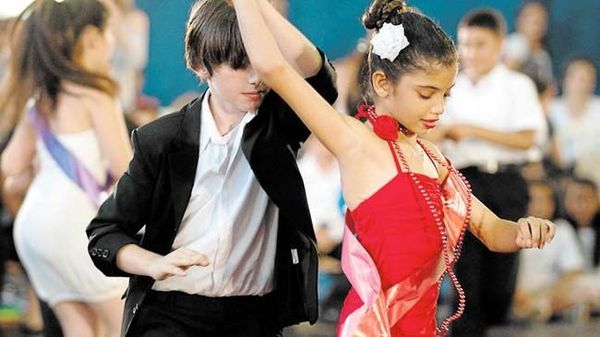Eye For Film >> Movies >> Dancing In Jaffa (2013) Film Review
Dancing In Jaffa
Reviewed by: Rebecca Naughten

Dancing in Jaffa follows champion ballroom dancer Pierre Dulaine as he returns to the city of his birth - for the first time since his family fled in the aftermath of the 1948 Arab-Israeli War - in the hope of teaching Jewish and Palestinian-Israeli children to dance together. Dulaine persuades five schools (two Jewish, two Palestinian, and one mixed) to take part, allowing Hilla Medalia's documentary to focus on three children with different backgrounds - Noor, Alaa, and Lois - and track the changes that learning to rhumba brings to their lives.
Dulaine - previously embodied on film by Antonio Banderas in Take The Lead (Liz Friedlander, 2006) - is a clear-eyed idealist; he knows that he is asking people to allow their children to dance with 'the enemy', even if no-one says that outright, but thinks the endeavour worth the effort. He is also admirably direct, whether firmly telling parents that he will be be teaching dancing properly - i.e. Arabs and Jews (and perhaps more problematically, the opposite sexes) will physically touch - or pointing out to a taxi driver that Jaffa was Palestinian territory prior to 1948 ("That's a fact").
The ten week period in which the Dancing Classrooms course takes place sees tensions rise in Jaffa when right wing Jewish activists stage a march through the port city, staking a claim to the land, followed by an annual Palestinian-Israeli demonstration calling for equal land and citizenship rights. In such fraught circumstances it is the adults who prove to be the most resistant to Dulaine's quest – as represented by the afore-mentioned taxi driver who states that having lost four friends during military operations in Gaza, he will never trust an Arab. When one parent quizzes her children as to whether Dulaine is Jewish or Arab, the children reply that they don’t know (“Maybe he’s English” offers the younger child - he's actually of Palestinian and Irish parentage). The scene neatly illustrates the dancer’s point that oppositional attitudes are taught - he believes that the formalised setting of ballroom dancing offers a space where children can be taught to respect one another irrespective of religious background.
However, the children present their own problems, not least in belonging to an age group who barely tolerate the opposite sex - "Yuck" is the oft-heard response to their being told to hold hands. Dulaine finally finds a way to connect with them through footage of him dancing with Yvonne Marceau some 35 years earlier. It gives the children a visual reference to aspire to, but also completely enthralls them - the girls coo over Marceau's grace, and small lads have ear-to-ear grins watching a youthful "Mister Pierre" glide across the dancefloor.
It becomes apparent that it is not just religion that divides these children, but also economics. Dulaine is aware that while he can give the children self-confidence, there is nothing he can do about the poverty in which some of the Palestinian-Israelis are living. The pairing of Lois (who wants for nothing) with Alaa (who lives a hand-to-mouth existence) illustrates the social gulf that Dulaine is trying to bridge and creates moments of unease when the disparity is thrown into relief - Lois's mother, worried that her little girl is going to be shown up by a down-at-heel dance partner, crassly enquires whether Alaa has a white shirt to wear for the dance competition, and would he like her to buy him some clothes. "I've got piles of white shirts" the lad replies, stoutly.
Meanwhile Noor - being brought up by a widowed Jewish convert to Islam - undergoes a transformation thanks to Dulaine's belief in her. Initially presented as a sullen and angry child - she is upset over the death of her father and struggles with being one of only a few Palestinian children in a Jewish school - Noor blossoms under Dulaine's encouragement into someone who holds her head up and learns to interact with other children, gaining confidence and friendship into the bargain. The look of sheer delight on the girl's face as she dances in the competition is the highlight of the film.
Medalia doesn't allow a political stance to overtly colour the camera's perception of events, but the film might have benefited from greater contextualisation beyond the brief historical overview at the start. The story told is generally more interesting than the telling of it. However, in sticking close to Dulaine and his young charges - and showing their success - the film is engaging and strikes a hopeful note.
Reviewed on: 12 Feb 2015
















